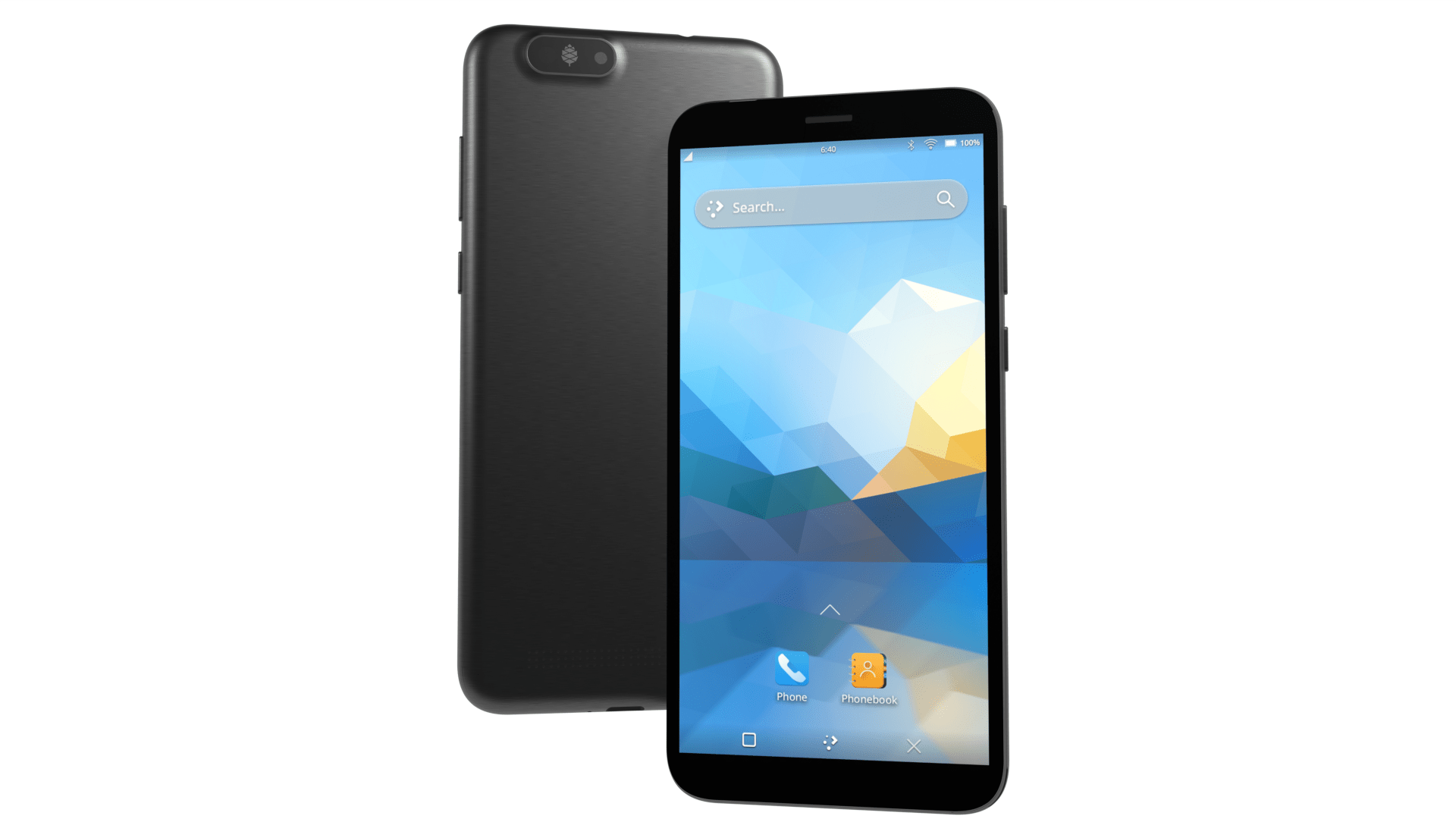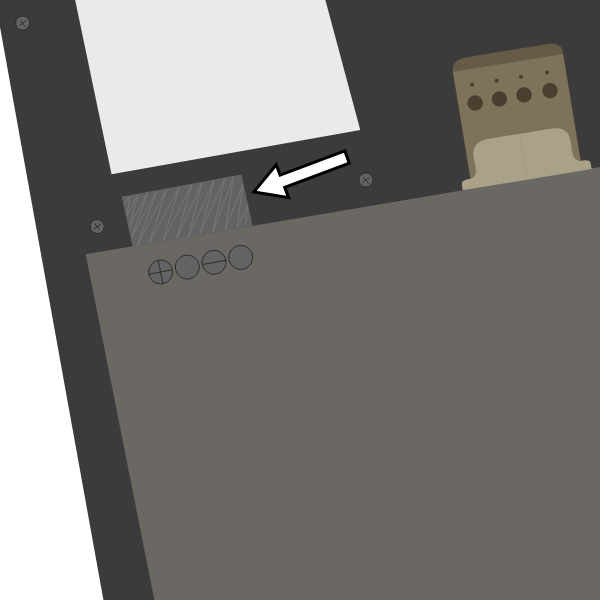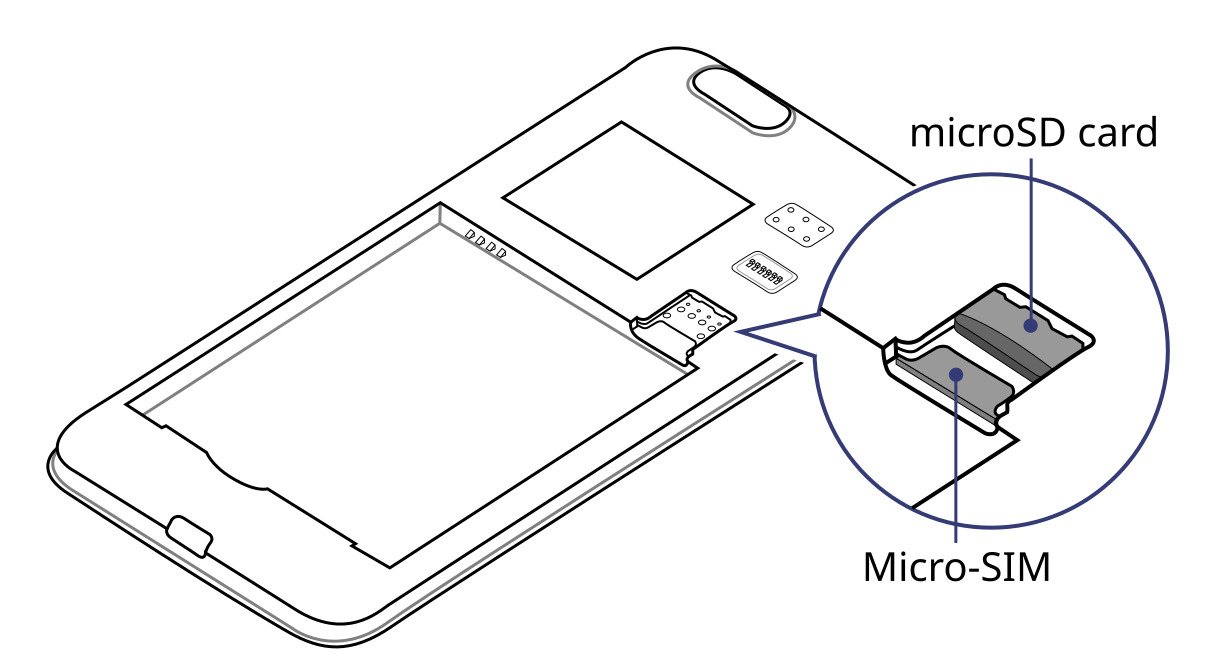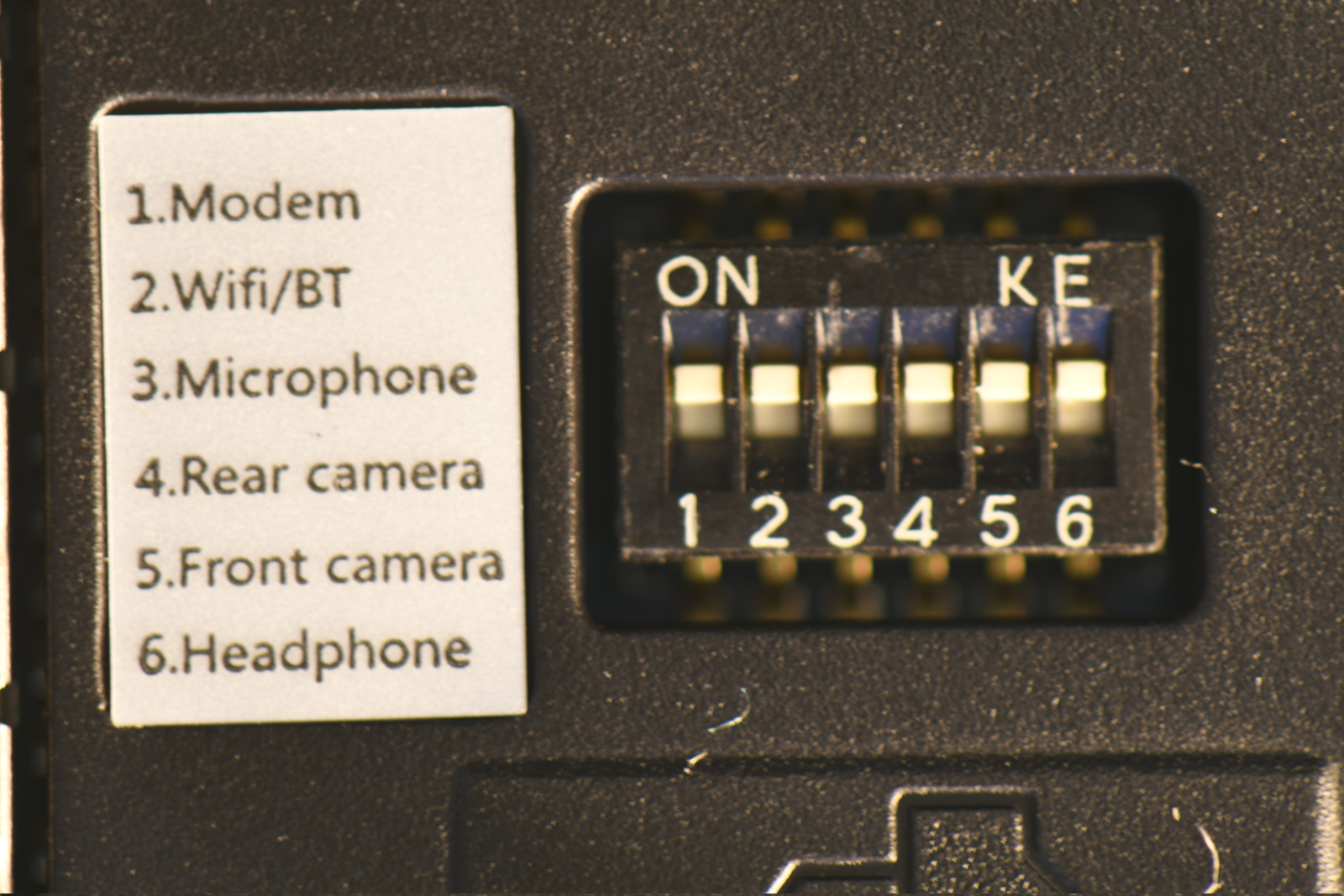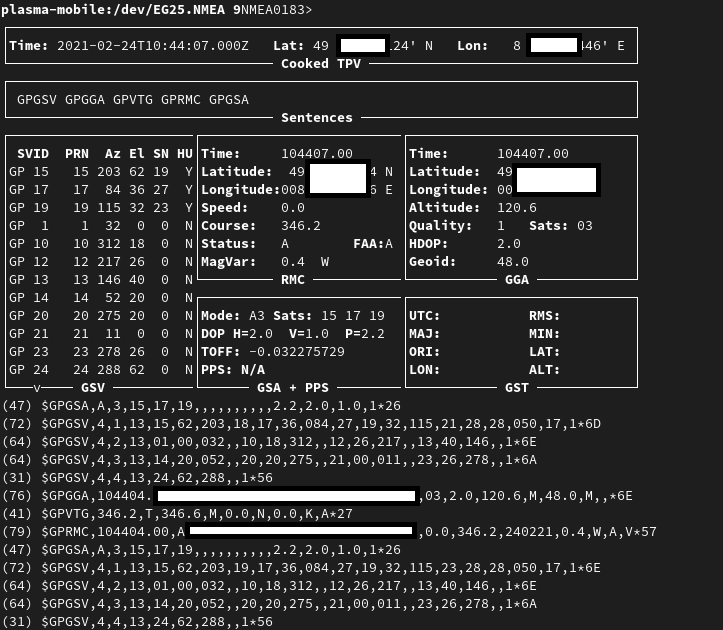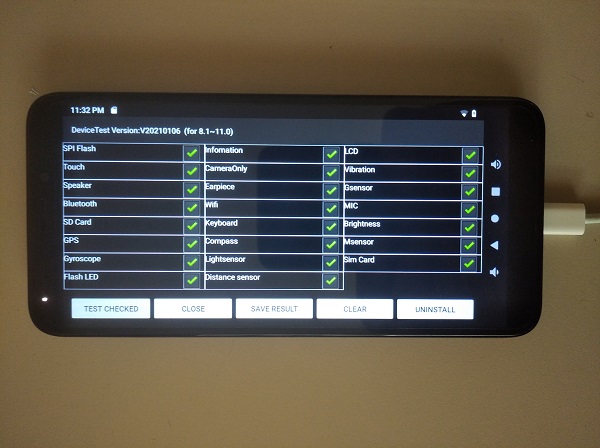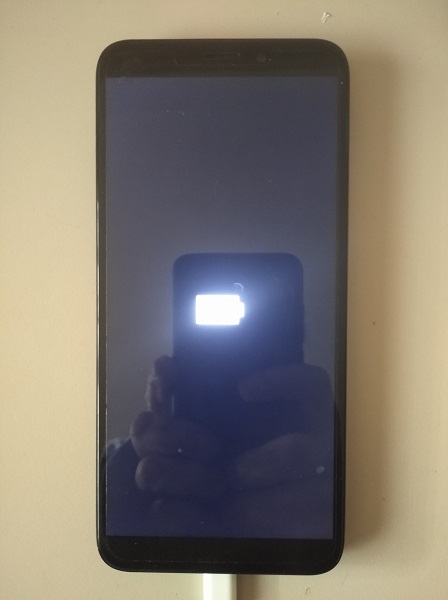Difference between revisions of "PinePhone Pro"
Tag: Reverted |
Tag: Rollback |
||
| Line 175: | Line 175: | ||
==== levinboot ==== | ==== levinboot ==== | ||
The levinboot bootloader is another option for the PinePhone Pro. The project repository can be found [https://gitlab.com/DeltaGem/levinboot/-/tree/master/ here]. (Pinephone Pro supporting fork is [https://xff.cz/git/levinboot/ here].) | The levinboot bootloader is another option for the PinePhone Pro. The project repository can be found [https://gitlab.com/DeltaGem/levinboot/-/tree/master/ here]. (Pinephone Pro supporting fork is [https://xff.cz/git/levinboot/ here].) | ||
== Privacy switch configuration == | == Privacy switch configuration == | ||
Revision as of 20:23, 9 September 2023
The PinePhone Pro is PINE64's flagship smartphone announced on October 15, 2021. It features 4GB of RAM, an 128GB eMMC and is using an Rockchip RK3399S SoC, which is a specialized version of the RK3399 made specifically for the PinePhone Pro.
Introduction
The PinePhone Pro is PINE64’s second smartphone and a successor to the original PinePhone. It does not, however, replace the original PinePhone. It should also not be considered a second generation PinePhone; it is a higher-end device, with much better specs, aimed at those who wish to daily-drive a open system stack. Achieving this goal will, however, take time as the software and overall smartphone software ecosystem needs to mature.
State of the software
Presently the PinePhone Pro Explorer Edition is aimed at Linux developers with an extensive knowledge of embedded systems and/or experience with mobile Linux. It will take time for all the PinePhone Pro’s functionality to reach software parity with the original PinePhone and for mobile operating systems, in more general, to reach a higher degree of maturity.
Bear in mind that the software for these smartphones is still in a very early stage, with most of the software being in alpha or beta state. That's especially also the case for scalability of applications, their availability and practicability, any hardware function implementations and the firmware. The software is provided as is. There is no warranty for the software, not even for merchantability or fitness for a particular purpose.
The following table lists the feature functionality status of the unaltered pre-installed factory image of the current shipping batch and as comparison an up-to-date reference image (no responsibility is accepted for the accuracy of this information, the list is provided and updated by the community). If you have any questions regarding the current state of the software or of specific features working, please don't hesitate to ask in the community chat before buying the device:
- Discord: #pinephone under https://discord.gg/pine64
- IRC: #pinephone on irc.pine64.org. Note: please consider Matrix, Discord or Telegram due to the volatile nature of IRC
- Matrix: https://app.element.io/#/room/#pinephone:matrix.org
- Telegram: https://t.me/pinephone
| Functionality | Component | Status (factory)¹ | Status (updated)² | Notes |
|---|---|---|---|---|
| Bootloader | Bootloader
|
Critical bugs | Some critical software bugs currently not fixed yet: A drained battery causes U-Boot to bootloop (cause is known and currently being worked on);Workaround Occasionally the eMMC fails to initializeReport. Note: Tow-Boot is now pre-installed on the SPI from the factory - issues need verification to be issues with Tow-Boot. | |
SPI
|
Implemented | Devices bought after end of July 2022 come with Tow-Boot flashed to the SPI memory, making it considerably easier to flash the device and boot from microSD card. | ||
Boot GUI
|
Not implemented | Currently there is no graphical boot selection implementedPossibly planned | ||
| Operating System | Stability
|
WIP | ||
Suspend
|
Experimental | Audio is often higher pitched after waking up from suspend due to a bug, make sure to update your systemReportReport | ||
Updates
|
WIP | The pre-flashed and outdated operating system on the eMMC often gets corrupted after updatingExample; Pacman database lock preventing updatesSolution; Keyring bug[Solution is to run "pinephonepro-post-install" script as root] | ||
| Modem | General
|
WIP | Alternative firmware; Slow wakeupReport; Some carriers blocking specific TANs in their networkPinePhone Carrier Support; Note: Proprietary firmware | |
Phone
|
WIP | The modem connection crashes frequently, which can lead to missed callsReportAlternative firmware; Slow wakeupReport; bad call audio qualityReport; Audio is often higher pitched after waking up from suspend due to a bugReportReport | ||
SMS
|
Working | SMS functionality is expected to work. In certain cases the functionality might be blocked by a clogged modemReport; Some bugs | ||
MMS
|
WIP | MMS functionality is integrated into the application "Spacebar", some bugs remaining and expected | ||
Push notifications
|
Not implemented | Receiving push notifications while the phone is suspended is not implemented | ||
| Components | LCD
|
WIP | Hardware issueDetails | |
Touch
|
Working | |||
Rear camera
|
Not working | WIP | Camera work-in-progress with DTS fix[Citation]; userspace still needs to do some catching updebugging article; Green image tint[Citation] | |
Front camera
|
Not working | WIP | Camera work-in-progress with DTS fix[Citation]; userspace still needs to do some catching updebugging article; Green image tint[Citation] | |
Camera flash
|
Critical issues | Hardware issueDetails; Note: /sys/class/leds/white:flash
|
||
WiFi
|
Working | WiFi is expected to work. The firmware does not support monitor mode and package injection. Note: Proprietary firmware | ||
Bluetooth
|
WIP | Bluetooth not necessarily working for calls yet due to missing audio routing[Citation]; Bluetooth in general dodgy under Pulseaudio.Info Note: Proprietary firmware | ||
GNSS/GPS
|
WIP | aGPS to be implementedSee original PinePhone article; long loading times to get a GPS fix[Citation]; No preinstalled application[Citation] | ||
Sensors
|
WIP | "Geo Magnetic Sensor" (af8133j): Status unknown (at /sys/bus/i2c/devices/4-001c/iio:device1)"Accelerometer / Gyroscope" ( | ||
Vibration motor
|
Working | |||
Notification LED
|
Working | |||
Buttons
|
Working | Power buttons and volume buttons are working. | ||
| Accessory compatibility, spare parts | Keyboard Add-on
|
WIP | The keyboard add-on compatibility is work-in-progress. | |
LoRa Add-on
|
Not implemented | No software support implemented | ||
Qi Wireless Charging Add-on
|
WIP | Wireless charging with the add-on case is expected to work to some degree. Certain software functionality and a driver is currently missing[Citation] | ||
Fingerprint Reader Add-on
|
Not implemented | No software support implemented | ||
Spare parts
|
Partial | Some spare parts now available in the store.Store | ||
| Software notes | Waydroid
|
Working | Waydroid is an Android container used to run Android applications. | |
¹ Status of the features at the time of the last factory installation without updates
² Status of the features with an up-to-date reference image
Editions and revisions
Similarly to the original PinePhone, various PinePhone Pro editions are planned, the first of which is the Developer Edition (aimed at developers, as the name entails) followed by the Explorer Edition, which is aimed at early adopters.
- PinePhone Pro Developer Edition
- PinePhone Pro Explorer Edition
Help and support
Still have any questions regarding software, shipping, or ordering after reading this Wiki? Please don't hesitate to contact the community in the bridged community channels for detailed answers or simply to chat with friendly people in the community! See Main Page#Community and Support.
Please keep in mind that PINE64 is not like a regular company (see the PINE64 philosophy) and that support resources are limited - the best way to get support quickly is to ask in the community chat! Please only contact the PINE64 support directly if questions couldn't be solved via the community chat or this wiki.
First time setup
When shipped the battery is isolated from the device using a protective plastic tab, which is required to be removed before using the phone. The battery will not charge or boot until it is removed and the battery is connected again.
The SIM card has to be placed in the lower slot, while the microSD has to be placed in the upper slot. Devices shipped after the end of July 2022 do only accept a nano-SIM, the SIM is inserted into a carriage released by slightly pulling on the handle in the lower slot (for information regarding devices shipped prior to end of July 2022 see below).
If the nano-SIM got released inside the adapter inside the phone, carefully reinsert the nano-SIM card without moving the adapter. In that case do not pull on the empty adapter as it will get stuck on the contact pins and damage them!
Software
The software section explains how to install the available software releases for the PinePhone Pro to the internal eMMC or a microSD card, how to boot them and how to solve common booting issues.
Software releases
The PinePhone Pro Software Releases page has a complete list of currently supported phone-optimized operating system images that work with the PinePhone Pro.
Boot order
The RK3399S processor in the PinePhone Pro searches for the bootloader (such as U-Boot or Tow-Boot) in the following order:
- SPI flash
- eMMC (the internal memory)
- MicroSD card
Boot from microSD card temporarily
To temporarily boot from an inserted microSD card do the following:
- On the Explorer Edition ordered after July 2022 hold the volume down key while powering on the device. The batches bought after July 2022 come with Tow-Boot flashed to the SPI, which offers additional functionality over U-Boot as bootloader.
- On the Explorer Edition ordered between January and July 2022 hold the RE button underneath the cover for a few seconds, while powering on the device. If the button is labeled RESET instead of RE please verify if the device is a regular PinePhone (or the Developer Edition). This is required because older batches don't ship with Tow-Boot on the SPI. Flashing Tow-Boot can be caught up by following this instruction. Note: If Tow-Boot is flashed later, the microSD card can be selected at boot with the volume down key as well.
- On the Developer Edition (sold to selected developers only) the SPI and the eMMC can be bypassed by shorting the bypass test points while booting. The process is explained in the article PinePhone Pro Developer Edition. Please join the community chat for any questions regarding the process.
The RE button disables the SPI and the eMMC at the hardware level while the button is held and the PinePhone Pro will try to boot from the next available boot medium, which is the microSD card. Note: When holding the RE button (or when shorting the contact points in case of the Developer Edition) for a longer time at boot the operating system will not initialize the SPI and eMMC and it will not be possible to write to these storage mediums until the next reboot.
Boot from microSD card permanently
The bootloader (such as U-Boot) resides in the free space in front of the first partition. Wiping the bootloader from the eMMC to make the PinePhone Pro boot from microSD card can be done using sudo dd if=/dev/zero of=/dev/mmcblk2 seek=64 count=400 conv=fsync. Formatting the drive or deleting the partition table is not sufficient to wipe the bootloader.
Notes
If you received your device after July of 2022, the bootloader (Tow-Boot) resides on the SPI. To boot to an SD card, place the SD card in your PinePhone Pro and turn it on. The phone will vibrate once. At this point, hold down the volume down button until you feel the device vibrate again then release the button. The LED color should change to blue and your display should remain black for a few seconds. In a few seconds you should see the SD card booting, the indications of which are dependent on what image you chose. If the LED is flashing instead, the boot from SD failed. Erasing the SPI can be achieved via the Tow-Boot installer image. Instructions are available here Tow-Boot PinePhone Pro Instructions.
See RK3399 boot sequence for further details regarding the boot sequence.
Installation instructions
The software releases can be installed (the process is being referred to as flashing) to the eMMC or to an microSD card.
Flashing to microSD card
To install an image to the microSD card:
- Download a compatible image from PinePhone Pro Software Releases.
- Important: Typically the image will be compressed in an archive file to reduce the download size (such as .gz or .xz). Extract the image from its archive file to get the file with the file extension .img.
- Write the image to your microSD card using your favorite method, examples:
- Using dd: On the device you're flashing the microSD card from, find the correct device under
lsblkand then flash the image to the microSD card usingsudo dd if=IMAGE.img of=/dev/[DEVICE] bs=1M status=progress conv=fsync. Make sure the target is the whole microSD card and not its first partition (sdc1 or mmcblk0p1 are wrong!). - Using bmaptool: Make sure to select the correct device using
lsblk. Then run bmaptool with the correct device: Download the IMAGE.xz and the IMAGE.bmap files, then runbmaptool copy --bmap IMAGE.bmap IMAGE.xz /dev/[DEVICE]. This takes around 2.5 minutes to flash a 4 GB file. - Using a graphical tool: A graphical tool such as Gnome Disks under Linux or Etcher under Windows may also be used.
- Using dd: On the device you're flashing the microSD card from, find the correct device under
- Insert the microSD card into the top slot of the PinePhone Pro. Make sure the microSD card is inserted all the way and that the notch of the right side of the microSD card is not visible anymore, see here.
- Boot the device using the following method:
- On the Explorer Edition ordered after July 2022 hold the volume down key while booting.
- On the Explorer Edition ordered between January and July 2022 hold the RE button underneath the back cover while booting (or use the volume down key if you flashed Tow-Boot).
- On the Developer Edition (sold to selected developers only) apply the bypass by shorting the testing pads while booting according to the datasheet (or use the volume down key if you flashed Tow-Boot).
Details regarding the boot order can be found in the Boot order section.
Flashing to the eMMC
Flashing to the eMMC (the internal memory of the PinePhone Pro) can either be done using Tow-Boot's USB Mass Storage mode (see #Boot order if you are unsure if the device comes with Tow-Bot pre-installed) or by booting an operating system from the microSD card (see the section Flashing to microSD card) and by writing to the eMMC directly from there:
By using Tow-Boot:
- Power off the device
- Power on the device and hold the volume up key before and during the second vibration
- The LED will turn blue if done successfully. This will only work if Tow-Boot is installed
- When connecting the device to a computer via USB it will behave like an USB drive now
- Check if the eMMC appears under
lsblk, the output might look like the following:- mmcblk2 179:0 0 115.2G 0 disk
- ├─mmcblk2p1 179:1 0 122M 0 part /boot
- └─mmcblk2p2 179:2 0 115.1G 0 part /
- Note: In this example, /dev/mmcblk2 is the device, while mmcblk2p1 and mmcblk2p2 are partitions of the device. The downloaded images are images from full devices, which means that the full device (mmcblk2 in this example) needs to be flashed. Ignore the partitions!
- Important: Typically the image will be compressed in an archive file to reduce the download size (such as .gz or .xz). Extract the image from its archive file to get the file with the file extension .img
- Flash the image file using
sudo dd if=IMAGE.img of=/dev/DEVICE bs=1M status=progress conv=fsync(replace IMAGE.img with the filename of the image you want to flash and make sure it has the file extension .img and replace DEVICE with the correct device from the lsblk command) - Reboot the PinePhone Pro
By booting a microSD card:
- Boot an operating system from the microSD card. If there is already a bootloader on the eMMC installed see the section Boot order to bypass it.
- Download or copy the desired image to the microSD card as file
- Check if the eMMC appears under
lsblk. If it doesn't appear in the output of the command, the eMMC wasn't initialized due to applying the above explained bypass method for a too long time during the boot - Important: Typically the image will be compressed in an archive file to reduce the download size (such as .gz or .xz). Extract the image from its archive file to get the file with the file extension .img.
- Flash the image file using
sudo dd if=IMAGE.img of=/dev/mmcblk2 bs=1M status=progress conv=fsync(replace IMAGE.img with the filename of the image you want to flash and make sure it has the file extension .img). - Reboot the PinePhone Pro
Troubleshooting
If the PinePhone Pro is not booting (either booting incompletely into a boot splash or tty or if the PinePhone Pro is showing no signs of life) this will typically have the following two reasons:
The battery is fully drained
If the battery is drained then the board can reset during boot causing a boot loop because of undervoltage condition. It can happen on all stages of the boot including U-Boot bootloader, display initialization and USB (re-)configuration. In that case it is not possible to charge the phone. The battery can be charged by interrupting the boot loop by booting the PinePhone Pro into Maskrom mode or by charging the battery externally. It is possible to follow these instructions without a computer by using a wall charger, however it would not be possible to determine if Maskrom mode was started successfully. To boot the PinePhone Pro into Maskrom mode:
- Remove any microSD card from the phone and keep it removed for the below procedure
- Remove the battery, any USB cable and any serial cable
- Reinsert the battery
- Hold the RE button underneath the back cover of your Explorer Edition (or short the bypass contact points on the Developer Edition)
- Connect the phone to an USB port of a computer, while still holding the button for some time
- Confirm if the phone was booted in Maskrom mode:
- On Linux check if the Maskrom mode appears as device in the output of the terminal command
lsusbon the computer, the expected VID:PID of the device is 2207:330c. - On Windows this can be checked using the Device Manager and checking the VID "2207" and PID "330c" of an Unknown device appears.
- On macOS this can be checked in /Applications/Utilities/System Information.app under USB and by checking if the VID "2207" and PID "330c" is appearing for a Composite Device.
- On Linux check if the Maskrom mode appears as device in the output of the terminal command
- Let the phone charge for multiple hours
The device should now be able to boot from the boot medium again. If that is not the case the installation got corrupted, as explained below.
The installation is corrupted
The PinePhone Pro won't be able to boot if the installation on the SPI flash, the eMMC or the microSD card got corrupted. To boot a working operating system:
- Prepare a microSD card as explained in the section Flashing to microSD card
- Remove any USB-C cable or device or add-on case from the PinePhone Pro
- Make sure the device is powered off by shortly removing the battery for a second
- Insert the microSD card into the top slot of the PinePhone Pro. Make sure the microSD card is inserted all the way and that the notch of the right side of the microSD card is not visible anymore.
- Power on the device while bypassing the SPI and eMMC as explained under Boot order
The device should now boot from the microSD card. If the phone does not boot from the microSD card the microSD card was flashed with an incompatible image or the battery got drained as explained above.
Bootloaders
The following section contains notes regarding compatible bootloaders with the PinePhone Pro.
U-Boot
The pre-installed operating system on the PinePhone Pro Explorer Edition, if sold prior to the end of July of 2022, is using U-Boot as default bootloader. Batches sold after July of 2022 are using Tow-Boot
Tow-Boot
Current batches of the PinePhone Pro ship with Tow-Boot pre-installed to the SPI flash, which is an opinionated distribution of U-Boot and brings numerous advantages over stock U-Boot, such as the possibility to choose from booting the eMMC or microSD card using the volume buttons during boot, as well as a USB Mass Storage mode, where the device can be written to by connecting the device to a computer via USB.
The user can flash Tow-Boot to the PinePhone Pro using the instructions on the Tow-Boot website.
levinboot
The levinboot bootloader is another option for the PinePhone Pro. The project repository can be found here. (Pinephone Pro supporting fork is here.)
Privacy switch configuration
The PinePhone features six switches that can be used to configure its hardware. They are numbered 1-6, with switch 1 located nearest to the modem. Their "on" position is toward the top of the phone.
| Number | Name | Description |
|---|---|---|
| 1 | Modem | "On" enables 2G/3G/4G communication and GNSS hardware, "off" disables it. |
| 2 | WiFi / Bluetooth | "On" enables WiFi and Bluetooth communication hardware, "off" disables it. |
| 3 | Microphone | "On" enables audio input from on-board microphones (not 3.5 mm jack), "off" disables it. |
| 4 | Rear camera | "On" enables the rear camera, "off" disables it. |
| 5 | Front camera | "On" enables the front camera, "off" disables it. |
| 6 | Headphone | "On" enables audio input and output via the 3.5 mm audio jack, "off" switches the jack to hardware UART¹ mode. |
¹ Note: The baud rate may be 1500000 instead of 115200.
Modem
The PinePhone uses Quectel EG25-G as modem. AT commands are used to communicate with the modem.
AT commands
A list of documented AT commands can be found for example in this AT commands documentation from Quectel. Further undocumented AT commands found by the developer megi, who reverse-engineered parts of the modem and its firmware, can be found on megi's website here.
To send AT commands to the modem under Linux, minicom or the often-preinstalled atinout utility can be used.
atinout example:
echo "AT+<command here>" | sudo atinout - /dev/ttyUSB2 -
minicom example:
minicom -D /dev/ttyUSB2
VoLTE
The PinePhone and PinePhone Pro modem supports VoLTE and comes with a few VoLTE profiles preloaded. Most operating systems try to set the correct profile automatically.
To list the available VoLTE profiles:
AT+QMBNCFG="list" +QMBNCFG: "List",0,1,1,"ROW_Generic_3GPP",0x0501081F,201901141 +QMBNCFG: "List",1,0,0,"VoLTE-ATT",0x0501033C,201909271 +QMBNCFG: "List",2,0,0,"hVoLTE-Verizon",0x05010141,201911251 +QMBNCFG: "List",3,0,0,"Sprint-VoLTE",0x05010205,201908141 +QMBNCFG: "List",4,0,0,"Commercial-TMO_VoLTE",0x05010505,201811231 +QMBNCFG: "List",5,0,0,"Telus-Commercial_VoLTE",0x05800C43,201912031 +QMBNCFG: "List",6,0,0,"Commercial-SBM",0x05011C18,201904021 +QMBNCFG: "List",7,0,0,"Commercial-DT",0x05011F1C,201905311 +QMBNCFG: "List",8,0,0,"Reliance_OpnMkt",0x05011B38,201910161 +QMBNCFG: "List",9,0,0,"TF_Germany_VoLTE",0x05010C1B,201909201 +QMBNCFG: "List",10,0,0,"TF_Spain_VoLTE",0x05010CFA,201909261 +QMBNCFG: "List",11,0,0,"Volte_OpenMkt-Commercial-CMCC",0x05012071,201904281 +QMBNCFG: "List",12,0,0,"OpenMkt-Commercial-CT",0x05011322,201911081 +QMBNCFG: "List",13,0,0,"OpenMkt-Commercial-CU",0x05011505,201807052
To select a profile manually, select the best fitting one or a generic one if none fits:
AT+QMBNCFG="select","ROW_Generic_3GPP"
Then enable Voice over LTE using:
AT+QCFG="ims",1
And reboot the modem to apply the settings:
AT+CFUN=1,1
To check the status of VoLTE during a call, the AT command CLCC can be used:
AT+CLCC +CLCC: 1,1,0,1,0,"",128 +CLCC: 2,1,0,1,0,"",128
In the fourth item of the list, "0" means voice and and "1" means data. If both rows have "1" then the voice call is being carried over VoLTE.
APN settings
The APN setting is only required for a public Internet connection ("data") on the phone. For tested APN settings and how to apply them see PinePhone APN Settings.
Carrier support
The page PinePhone Carrier Support contains information about the frequency support of different carriers and hints on setting up cellular network connectivity.
Documents
Detailed information about the modem can be found on the page of the developer megi, including reverse-engineered parts of the firmware and its functions. There is also a document about using the modem from January 18th 2020 by megi here. A script at the end of the document showcases a way to power off the modem before powering off the phone, which is integrated into most of the available operating systems.
Firmware update
There is a (nearly) free custom firmware and the stock firmware available for the PinePhone Pro. Both can be updated to a newer version with new features and bug fixes.
Custom firmware
There is a (nearly) free custom firmware for the PinePhone and PinePhone Pro modem by the developer biktorgj, which can be found here.
The custom firmware has various advantages (and zero disadvantages) over the stock firmware, including:
- Signal tracking support with checks against the OpenCelliD database
- Persistent storage is optional and unexpected shutdowns don't mess up the modem
- A lower energy consumption due to the lower minimum clock frequency
- And many more, see Features not available on stock firmware
The custom firmware can be flashed using fwupd or a flashing script.
Stock firmware
The stock modem firmware can be updated to a newer version if it is outdated. The firmware version can be checked using the following AT command (at the example of atinout, alternatively minicom can be used to communicate with the modem too):
echo 'AT+QGMR' | sudo atinout - /dev/ttyUSB2 -
Pre-update checklist:
Please make sure all requirements of the checklist are fulfilled. If the update process is interrupted it will lead to a corrupted firmware of the modem, causing it to brick. Recovering a bricked modem is exponentially more complicated and requires the user to boot a special mode by physically bridging test points on the modem.
- The battery needs to be charged sufficiently
- The phone needs to be plugged into a charger
- Deep sleep is recommended to be disabled as it can interrupt the update process
- It is recommended to close all other running applications
- Use common sense while doing the update, don't do the update while being impaired in any way
To get the latest firmware, clone the repository of user Biktorgj on the phone:
git clone https://github.com/Biktorgj/quectel_eg25_recovery
After cloning the directory, open it with cd:
cd quectel_eg25_recovery
Then run qfirehose, which starts the flashing process:
sudo ./qfirehose -f ./
The modem will automatically reboot after the update process is done. The boot process takes around 30 to 60 seconds. After that it is highly recommended to reboot the device.
Firmware modifications
See PineModems for more information regarding modem bootloader unlocking, building a custom modem firmware and modem recovery.
GPS / GNSS
The GPS engine in the modem supports mutli-GNSS reception from GPS, GLONASS, BeiDou, Galileo and QZSS independent of a cellular connection. The operation of the GNSS subsystem can be controlled via a separate set of AT commands, or via qmi. The A-GPS data upload uses the file management AT commands, which also have their own manual. These are linked in the documentation section.
As with most smartphones, the PinePhone Pro has a small antenna and has difficulty getting a first fix without assistance data, a cold start can take 15 minutes under good conditions. The eg25-mananger is configured to upload A-GPS data by default (see here).
Basic testing of GNSS reception can be done by using the AT command interface (/dev/ttyUSB2) from a terminal program like minicom and the data output interface (/dev/ttyUSB1) to feed NMEA data into gpsmon or some other program that can parse standard NMEA sentences.
To check if GNSS data output is enabled, you can
cat /dev/ttyUSB1
this should display a stream of NMEA sentences
$GPVTG,,T,,M,,N,,K,N*2C $GPGSA,A,1,,,,,,,,,,,,,,,,*32 $GPGGA,,,,,,0,,,,,,,,*66
Further details can be found under PinePhone Sensors and Navigation.
Voice mail
The operating systems of the PinePhone Pro may not have support for accessing your voicemail by holding down the 1-key. Carriers might support accessing the voice mail via an external number however.
Specifications
- Dimensions: 160.8 x 76.6 x 11.1mm
- Weight: Approx. 220g
- SIM Card: Nano-SIM (Micro-SIM before 07/2022)
- Display:
- Size: 6 inches (151mm) diagonal
- Type: 1440 x 720 in-cell IPS with Gorilla Glass 4™
- Resolution: 1440x720, 18:9 ratio
- System on Chip: Rockchip RK3399S 64bit SoC – 2x A72 and 4x A53 CPU cores @ 1.5GHz
- RAM: 4GB LPDDR4 @ 800MHz
- Internal Storage: 128GB eMMC, extendable up to 2TB via microSD, supports SDHC and SDXC
- NOR Flash: Listed as [GigaDevices] GD25LQ128EWIGR, but physical inspection found a SiliconKaiser SK25LP128.
- Back Camera: 13MP Sony IMX258 with Gorilla Glass 4™ protective layer, LED Flash
- Front Camera: 8MP, OmniVision OV8858 front-facing camera
- Sound: Loudspeaker, 3.5mm jack & mic (jack doubles as hardware UART if hardware switch 6 is deactivated)
- Communication:
- Modem: Quectel EG25-G
- LTE-FDD: B1, B2, B3, B4, B5, B7, B8, B12, B13, B18, B19, B20, B25, B26, B28
- LTE-TDD: B38, B39, B40, B41
- WCDMA: B1, B2, B4, B5, B6, B8, B19
- GSM: B2, B3, B5, B8 (850, 900, 1800, 1900 MHz)
- WLAN & Bluetooth: Wi-Fi 802.11AC, hotspot capable + Bluetooth V5.0
- GNSS: GPS/GLONASS/BeiDou/Galileo/QZSS, with A-GPS
- Sensors: Accelerometer, gyroscope, proximity, ambient light, compass
- Privacy switches: Modem, WiFi & Bluetooth, Microphone, Cameras
- Battery: Lithium-ion, rated capacity 2800mAh (10.64Wh), typical capacity 3000mAh (11.40Wh) (nominally replaceable with any Samsung J7 form-factor battery; unglue bottom black plastic with your nail from Samsung battery before installation in order to match the dimensions)
- I/O: USB Type-C, USB Host, DisplayPort Alternate Mode output, 15W 5V 3A Quick Charge, follows USB PD specification
Modifications and repairs
Most parts are available from the Pine store. Take care to use this link to avoid unintentionally ordering parts for the original PinePhone instead.
Replacing the mainboard
The mainboard can be replaced if it is faulty. The replacement board does not have an operating system pre-installed, to test if everything is working after swapping the mainboard a flashed SD card is required.
Prior to replacing your PinePhone Pro’s mainboard please read the steps outlined in bullet points below and watch the attached video.
- You’ll need a small Phillips screwdriver and a prying tool to swap out the mainboard.
- Remove the phone's back cover. See your quick start guide for details.
- Remove the battery as well as any inserted SD and SIM cards.
- Unscrew all 15 Phillips head screws around the midframe of the phone, including the screw under the warranty sticker.
- Gently pry up the midframe using a guitar pick or credit card corner. It is easiest to separate the midframe at one of the bottom edges. Work your way around all the sides of the phone until the midframe separates from the phone’s body.
- Detach all ribbon cables and “Lego” connectors. List of things to detach: 1) two “Lego” connects at the bottom of the mainboard. 2) u.FL antenna connect and touchscreen digitizer on PCD left side. 3) LCD ribbon cable top of mainboard, next to audio and UART jack.
- Pry the mainboard up gently from the left-hand side.
- Remove front and main cameras and reset them into the new mainboard.
- Place the new mainboard in the chassis, hooking in on the plastic tabs on left side and pressing down firmly on opposite side, and follow the steps (7-2) in reverse. When reattaching the midframe take care that no cables are out of place or trapped, as they may be damaged when tightening screws.
After swapping the mainboard the phone won't boot as there is no OS on the replacement board's eMMC preinstalled. To boot an OS insert a flashed SD card.
A video tutorial by Martijn Braam for the regular PinePhone can be found here or alternatively a video tutorial by user brigadan with additional notes about the camera swap and proximity sensor isolator here.
Replacing the screen
Before attempting to replace the screen be sure to review the section on replacing the mainboard since that will get you most of the way there. Be aware that the replacement screen is actually the entire front frame of the phone and there are components that will need to be swapped from your old screen.
- Make sure you have a precision screwdriver set that has the correct size Philips tip. The screws are very small and the heads can easily be stripped if the screwdriver is not correct - if you feel your screwdriver slipping, stop what you are doing and try one that is a better fit. A magnetized screwdriver will help in not losing screws, as will a magnetic parts holder to keep them in while working.
- There are a number of components and cables as well as the insulator sheet under the battery that are glued in place. A hair dryer will loosen the glue and make them much easier to remove. You may want to order extra cables along with the screen just in case.
- The vibration motor, which is part of the USB-C board assembly and glued into place, will come apart easily and be damaged if you pry it up in the wrong place. Make sure you pry from underneath the complete part, not midway on its housing. The ribbon cable attaching this to the USB-C board is small, thin, and fragile so be careful with that as well.
- The new screen comes with new side switches and insulator sheet but there are a number of parts that need to be transferred from the old screen, like the thin coax cable running up the side, the phone ear speaker, proximity sensor gasket, and a silver-colored mesh glued in place that needs to be transferred to a flexible circuit included on the new screen. If you don't swap over the proximity sensor rubber gasket the screen will immediately turn off after logging in. Be careful when routing the coax cable that it goes around the screw holes or you may drive a screw right through the cable.
Take your time, use the right tools, be careful and you should be rewarded with success.
Spare parts not available in the Pine Store
The following parts are not available on the Pine Store for the regular PinePhone. The replacements are listed below and have not been validated for the PinePhone Pro.
- Earpiece: See PinePhone (Pro) replacement earpieces
- Loudspeaker dimensions: 15x11x3 mm. Compatible with Nokia N91, Lenovo A536 (requires soldering) and others, see here
- Proximity sensor rubber isolator
Components
| Component | Model |
|---|---|
| Touchscreen | Goodix GT917S |
| LCD | Himax HX8394 compatible |
| Rear camera | IMX258 |
| Front camera | OV8858 |
| Camera flash | AW3641EDNR |
| WiFi + Bluetooth | AzureWave AW-CM256SM |
| Modem | Quectel EG25-G |
| GNSS/GPS | Quectel EG25-G |
| Geo Magnetic Sensor | Voltafield AF8133J |
| Ambient light / Proximity | STK3311-A |
| Accelerometer / Gyroscope | TDK MPU-6500 |
| Vibration motor | |
| Notification LED | LED0603RGB |
| Audio Codec | ALC5616 and ALC5640 |
| Volume buttons | Buttons connected to the KEYADC |
| Power button | |
| Battery fuel gauge | RK818 |
Datasheets, schematics and certifications
PinePhone Pro mainboard schematic:
- PinePhone Pro mainboard Explorer Edition Released Schematic ver 1.0 20211127
- PinePhone Pro mainboard Explorer Edition component top placement ver 1.0 20211127
- PinePhone Pro mainboard Explorer Edition component bottom placement ver 1.0 20211127
PinePhone Pro USB-C small board schematic:
- TBD
Certifications:
- PinePhone Pro FCC Certificate
- PinePhone Pro SAR Evaluation Report
- PinePhone Pro CE RED Certificate
- PinePhone Pro ROHS Test Report
Factory Test Build for Hardware Checking
Please note that this Android build solely for PinePhone Pro hardware checking purpose and solely used by the support team. This is NOT a general release build.
Download:
- Direct download from pine64.org (722MB, for 8GB microSD cards or bigger, MD5 of the GZip file 214e063c8205c1a98d44b2015a21bb5d)
Instructions:
- Download the build, extract the image and dd it to a 8 GB or larger microSD card, take out the PinePhone Pro Explorer Edition, then insert it into microSD slot (upper slot).
- Insert battery, press the RE button (bypass SPI and eMMC boot) underneath the back cover while plugging in the USB-C power. After 3 seconds release the RE button.
- When powering up, a battery icon screen will show up blow, press power key for two seconds, then the Rockchip logo screen shows up.
- Wait for the home screen, double tap on the test app icon (mark red circuit) and this will bring up the factory test screen. Please note that the SD test is disabled due in this is SD boot build.
- After running a particular test function, please snapshot the test result and pass it back to support team
Notes:
- Please insert a functional SIM card when performing the SIM test
- When perform GPS test, the first result may fail and please ignore this false message.
- For light sensing test, please have a light shine to the PinePhone Pro when performing the test.
Using Factory Test Build for Battery charging
Please note that this Android build solely for PinePhone Pro hardware checking purpose and solely used by support team. This is NOT a general release build.
Download:
- Direct download from pine64.org (722MB, for 8GB microSD cards or bigger, MD5 of the GZip file 214e063c8205c1a98d44b2015a21bb5d)
Instructions:
- Download the build, extract the image and dd it to a 8 GB or larger microSD card, takes out the PinePhone Pro Explorer Edition then insert it into microSD slot (upper slot).
- Insert battery, press RE button (bypass SPI and eMMC boot) while plug in USB-C power. After 3 seconds release RE button.
- When power up, below battery icon screen show up and battery will start charging.
- The battery icon display for few seconds and then LCD panel turn off while charging. To check charging status, just quick press power button (about 0.5 second) and battery icon will display progress.
Press
For an overview about media of the PinePhone Pro you can use for the news, blogs, or similar see PinePhone Press.
External links
- Product Page
- Announcement video
- Blog post with the announcement
